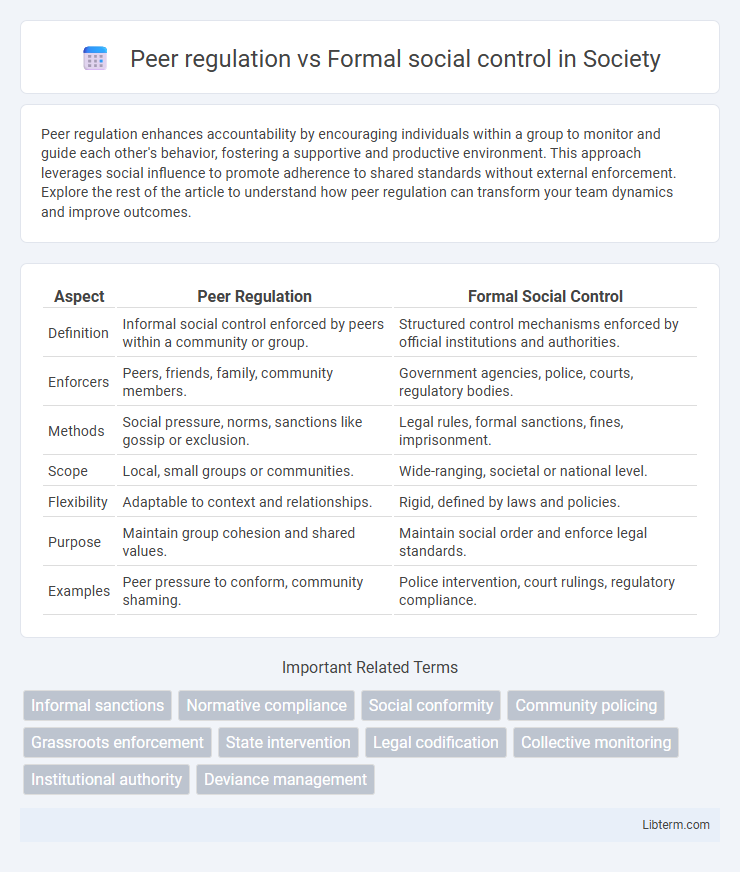Peer regulation enhances accountability by encouraging individuals within a group to monitor and guide each other's behavior, fostering a supportive and productive environment. This approach leverages social influence to promote adherence to shared standards without external enforcement. Explore the rest of the article to understand how peer regulation can transform your team dynamics and improve outcomes.
Table of Comparison
| Aspect | Peer Regulation | Formal Social Control |
|---|---|---|
| Definition | Informal social control enforced by peers within a community or group. | Structured control mechanisms enforced by official institutions and authorities. |
| Enforcers | Peers, friends, family, community members. | Government agencies, police, courts, regulatory bodies. |
| Methods | Social pressure, norms, sanctions like gossip or exclusion. | Legal rules, formal sanctions, fines, imprisonment. |
| Scope | Local, small groups or communities. | Wide-ranging, societal or national level. |
| Flexibility | Adaptable to context and relationships. | Rigid, defined by laws and policies. |
| Purpose | Maintain group cohesion and shared values. | Maintain social order and enforce legal standards. |
| Examples | Peer pressure to conform, community shaming. | Police intervention, court rulings, regulatory compliance. |
Introduction to Peer Regulation and Formal Social Control
Peer regulation involves individuals within a social group enforcing norms and behaviors through informal sanctions like approval or disapproval, enhancing group cohesion and self-policing. Formal social control relies on institutional mechanisms such as laws, police, and courts to maintain order and enforce compliance through codified rules and official penalties. Understanding the contrast highlights how social order is maintained both through community-based interactions and structured legal frameworks.
Defining Peer Regulation: Concepts and Examples
Peer regulation involves individuals within a social group influencing each other's behavior through norms, expectations, and mutual accountability without formal authority. Examples include student-led study groups enforcing punctuality or workplace teams setting informal productivity standards. This contrasts with formal social control, which relies on institutional rules, laws, and designated authorities to maintain order.
What is Formal Social Control? Mechanisms and Institutions
Formal social control refers to the structured and institutionalized mechanisms used to regulate behavior and maintain social order, often enforced by authorized entities such as law enforcement agencies, courts, and government bodies. These institutions implement formal rules, laws, and sanctions that are officially codified and systematically applied to ensure compliance and address deviance. Mechanisms of formal social control include legal regulations, policing, judicial proceedings, and correctional systems, which collectively work to uphold societal norms and protect public safety.
Historical Evolution of Social Control Methods
Peer regulation emerged as a decentralized and community-based method of maintaining social norms, rooted in early human societies where small groups enforced behavior through mutual expectations and social pressures. Formal social control developed alongside the rise of complex states, institutionalizing laws, policing, and judicial systems to regulate behavior on a larger scale. Historical evidence shows a transition from informal, peer-driven mechanisms in tribal and pre-state societies to codified legal systems in ancient civilizations like Mesopotamia and Rome.
Key Differences: Peer Regulation vs Formal Social Control
Peer regulation relies on informal social norms and group dynamics to influence behavior, often involving mutual monitoring and social sanctions within communities. Formal social control depends on official institutions, such as law enforcement, courts, and regulatory agencies, to enforce rules and impose penalties through legal authority. The key difference lies in the source of authority: peer regulation emerges internally from social relationships, while formal social control is externally imposed by codified laws and structured governance.
Benefits and Limitations of Peer Regulation
Peer regulation fosters community accountability by encouraging individuals to influence each other's behavior through shared norms and informal sanctions. Benefits include increased trust, quicker conflict resolution, and cost-effectiveness compared to formal social control systems. Limitations arise from potential bias, inconsistent enforcement, and lack of authority to impose penalties in serious violations.
Strengths and Weaknesses of Formal Social Control
Formal social control, implemented through laws, regulations, and official institutions, provides clear guidelines and consistent enforcement that maintain social order and deter deviant behavior effectively. Its strengths include the authority to impose sanctions and the ability to address complex societal issues systematically. However, weaknesses involve potential rigidity, bureaucratic delays, and the risk of disproportionately targeting marginalized groups, which can undermine trust and social cohesion.
Case Studies: Peer Regulation in Practice
Case studies of peer regulation in practice reveal its effectiveness in fostering community accountability through shared norms and mutual reinforcement, often within schools and online platforms. Unlike formal social control, which relies on institutional authorities and legal frameworks, peer regulation harnesses social influence and informal sanctions to curb deviant behavior. Research indicates peer regulation promotes more sustainable compliance by leveraging trust, social identity, and collective responsibility among group members.
Social Outcomes of Formal vs Peer-Controlled Environments
Formal social control, characterized by institutionalized laws and regulations, typically results in predictable social outcomes such as compliance and reduced deviance through structured sanctions and enforcement. Peer regulation, grounded in informal group norms and mutual expectations, fosters social cohesion and internalized conformity, often enhancing trust and cooperation within the group. Environments dominated by formal control may limit spontaneity but ensure stability, while peer-controlled settings promote engagement and adaptability, influencing behavior through social identity and peer pressure.
Future Trends in Social Regulation: Integration and Innovation
Future trends in social regulation emphasize the integration of peer regulation and formal social control mechanisms to enhance community resilience and adaptability. Innovations in digital platforms enable real-time feedback and collective monitoring, blending informal peer influence with structured legal frameworks. This hybrid approach promotes more dynamic, responsive governance models that leverage social trust and institutional authority simultaneously.
Peer regulation Infographic

 libterm.com
libterm.com